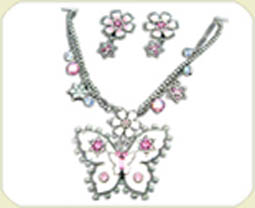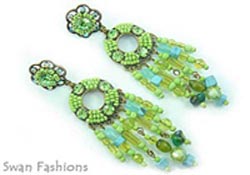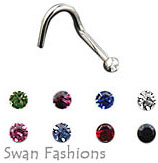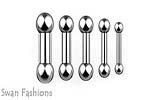LIP RING OR LABRET STUD?A piercing once healed will last a lifetime so you must decide carefully if you would rather wear a ring or a stud. There is a difference in angle placement for a ring or a stud. However, you can change the jewellry later on. A stud will not sit in a ring piercing at as nice an angle.
Aesthetically, most people prefer the look of a labret stud to a ring, and a stud is more versatile as it’s easier to change the jewellery and there's a huge range of labret studs available now.
PLACEMENT & JEWELLERYThe placement for a ring can be virtually anywhere along the lip, and the piercing can be done with either 1m or 1.6mm rings of various diameters depending on the look you want. Thinner gauge jewellery heals quicker but has a greater chance of nesting. Rings are available in Surgical Steel, Gold Plated Steel and solid Gold.
A labret stud is like a small bolt with a ball on one end and a flat plate on the other that goes on the inside of the mouth. They are generally pierced at an angle so the backplate doesn't rub on the gums. Labrets are mostly positioned in the centre of the lower lip about 5-10 mm below the lip-line. Labrets are occasionally positioned in the corner of the upper lip, in the position of an old-fashioned beauty mark. This piercing is called a "Chrome Crawford" after the Model Cindy Crawford. Many different types of Labret studs are available; Surgical Steel, Gold-plated Steel, Glow-in-the-dark Lucite, solid Gold, and 18ct Gold and Steel set with your choice of gemstones and attachments.
HEALINGLip & Labret piercing usually take between 6-10 weeks to fully heal, it is very rare to develop an infection because the mouth contains an enzyme "Ptyalin" which inhibits bacteria. You will experience swelling usually 2-3 days after the piercing, this swelling can last 7-10 days. A longer Labret stud must be worn till the initial swelling has gone down; a shorter one can then replace it.
Lip & Labret piercings have a tendency to move position on the inside of the lip, this process is called nesting. Rings have a greater tendency to do this than labrets because they tend to move around more, which puts stress on the wound. When the lip is pierced the membrane of thin skin inside the mouth is cut, this skin can then move back over the labret stud. Eventually this skin will die off and a depression will form where the stud sits, this can take weeks though and in the meantime the back of the stud can become embedded in the wound. Don't be alarmed if this happens, this is quite common but in time the wound will settle down.
JEWELLERY OPTIONS - Once your piercing is healed there is huge variety of jewellery available for labrets. Jeweled studs, colored acrylic balls and spikes, UV acrylic shapes, spikes, gemstone studs, steel balls, gold-plated steel balls, 14k and 18ct gold balls and shapes.
DO'S & DON'TS TO CARE FOR YOUR LIP/LABRET PIERCINGTHE NUMBER ONE REASON FOR INFECTION IS TOUCHING OR PLAYING WITH THE PIERCING, ONLY TOUCH THE PIERCING WHEN CLEANING!
· DO rinse your mouth with a mouthwash such as Listerine or cepacol after meals or eating. For the first 2 weeks you should suck on antibacterial/anti-inflammatory throat lozenges (Difflam-C), these reduce the chance of infection and reduce swelling.
·
DO clean the front of the piercing by soaking a cotton wool ball in salt water or Saline and leaving it on the piercing for 2-3 minutes to dissolve the crusting in the morning. Dissolving 1/2 teaspoon of Sea Salt in a 1/4 glass of warm water, or use Saline (from any Chemist) can make salt water.
· DO use Lavender oil as it promotes healing and lubricates the wound reducing tenderness. Apply a small amount with a cotton-wool bud (to the front) after cleaning, then move the jewellery so it gets into the wound. Remove any excess with a tissue as leaving it on can cause the skin to become irritated. It may be purchased at supermarkets (medicine section) or at chemists and must be marked (BP) or medicinal grade.
· DO eat things such as frozen yogurt, ice cream, cold foods, or suck on chipped or crushed ice, or very small ice blocks for the first 2 weeks. Cold things help the healing, alleviate pain and reduce swelling.
· DO remove the plaque and crusting which can form on the jewellery, do this very gently with a soft toothbrush during the healing period.
· DO be careful when chewing that so you don't bite the labret stud/ring and shatter a tooth!
· DO check once a month that the jewellery is screwed on tight. Clean hands with a germicidal soap before handling the jewellery. The ball that screws off is on the front, and it must be turned clockwise to tighten.
· DON'T pick at the scab on the front of your lip, as this can cause infections, excessive scar tissue and can lead to lumps forming.
· DON'T put anything dirty in your mouth such as fingernails, pens, etc. And you must refrain from oral sex for the first month, this includes kissing even if you are in a monogamous relationship.
· DON’T play with the jewellery or chew on it during the healing period as this can lead to excess scar tissue formation. If you develop the habit of chewing on the jewellery you will eventually damage you teeth by wearing them down, this may result in a costly visit to the dentist.
· DON'T remove or replace the jewellery during the healing period, as the hole closes up very quickly and it's painful to reinsert the jewellery once this happens. Even after the wound is healed, the hole will close up if you remove the jewellery. It can take up to 1-2 years before you will be able to remove the jewellery for anything more than a day.
This Piercing Aftercare Information is taken from the site: http://www.navelring.com/information/lipandlabret.htm





